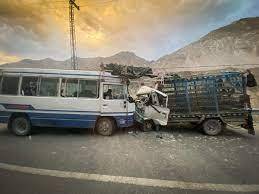
Road accidents can be described as an epidemic in Pakistan. On February 7 2023, 19 people were killed and 14 sustained critical injuries when a Rawalpindi-bound coach collided with a car. Both vehicles fell into a ravine in Kohistan.
Nine day before the accident in Kohistan, 40 people were killed when a passenger bus crashed into a pillar and fell off a bridge in Lasbela district of Balochistan. Earlier, on November 17 2022, at least 20 people were killed and 13 injured after a passenger van fell into a ditch near Sehwan in Sindh.
On August 16 2022, two deadly accidents were reported: twenty people were killed and six injured when a passenger bus collided with an oil tanker on the Multan-Sukkur Motorway and eight people were killed when a passenger coach plunged into a ditch near Rohri on the Sukkur-Multan motorway.
That sums up to 107 deaths and many more injured in road accidents in less than six months. These are disasters that caught the media’s cursory attention. They should have made headlines but were relegated to side columns. Many more went unreported. The fatal collisions killed stories of men returning home after months of hard work and dreams of students going home from colleges for holidays. Mothers and children were onboard as well.
Yet, the Pakistani authorities are not recognising the gravity of the problem. Road safety is not a target in the country. Absence of road safety management, poor condition of vehicles, ineffective speed monitoring, and reckless behaviour of drivers has turned roads into death traps.
According to the Pakistan Bureau of Statistics’ (PBS) numbers, in 2021 nearly 10,376 accidents killed 5,600 and injured 13,060 people in road accidents in the country. Compared to PBS figures from 2020, 2021 showed an increase in the number of accidents and people killed or injured.
The current focus of our lawmakers is more on modernising road networks. They look good and win votes. But wider, swankier, faster roads are not necessarily safer – because people start seeking thrill in speed.
In a country where dangerous and risky driving of old and badly maintained buses and trucks is a norm, not an exception, road safety infrastructure alone will not make our highways safe. The driving culture needs a serious overhaul. We must stop believing that a person’s time of death is fixed and cannot be avoided and that dying in a tragic accident was their destiny.
Ahsan Ul Haq Kayani, a senior patrolling officer with the national highways and motorways police in Pakistan, wrote in an article for the Guardian that fatalism is so ingrained in everyday thinking and mindsets that it is certainly a major contributing factor to the high numbers of people that die on the roads every year.
Let’s not leave deaths to fate. Road accidents are bound to happen but can they be made less fatal?
Nine day before the accident in Kohistan, 40 people were killed when a passenger bus crashed into a pillar and fell off a bridge in Lasbela district of Balochistan. Earlier, on November 17 2022, at least 20 people were killed and 13 injured after a passenger van fell into a ditch near Sehwan in Sindh.
On August 16 2022, two deadly accidents were reported: twenty people were killed and six injured when a passenger bus collided with an oil tanker on the Multan-Sukkur Motorway and eight people were killed when a passenger coach plunged into a ditch near Rohri on the Sukkur-Multan motorway.
That sums up to 107 deaths and many more injured in road accidents in less than six months. These are disasters that caught the media’s cursory attention. They should have made headlines but were relegated to side columns. Many more went unreported. The fatal collisions killed stories of men returning home after months of hard work and dreams of students going home from colleges for holidays. Mothers and children were onboard as well.
Yet, the Pakistani authorities are not recognising the gravity of the problem. Road safety is not a target in the country. Absence of road safety management, poor condition of vehicles, ineffective speed monitoring, and reckless behaviour of drivers has turned roads into death traps.
According to the Pakistan Bureau of Statistics’ (PBS) numbers, in 2021 nearly 10,376 accidents killed 5,600 and injured 13,060 people in road accidents in the country. Compared to PBS figures from 2020, 2021 showed an increase in the number of accidents and people killed or injured.
The current focus of our lawmakers is more on modernising road networks. They look good and win votes. But wider, swankier, faster roads are not necessarily safer – because people start seeking thrill in speed.
In a country where dangerous and risky driving of old and badly maintained buses and trucks is a norm, not an exception, road safety infrastructure alone will not make our highways safe. The driving culture needs a serious overhaul. We must stop believing that a person’s time of death is fixed and cannot be avoided and that dying in a tragic accident was their destiny.
Ahsan Ul Haq Kayani, a senior patrolling officer with the national highways and motorways police in Pakistan, wrote in an article for the Guardian that fatalism is so ingrained in everyday thinking and mindsets that it is certainly a major contributing factor to the high numbers of people that die on the roads every year.
Let’s not leave deaths to fate. Road accidents are bound to happen but can they be made less fatal?

